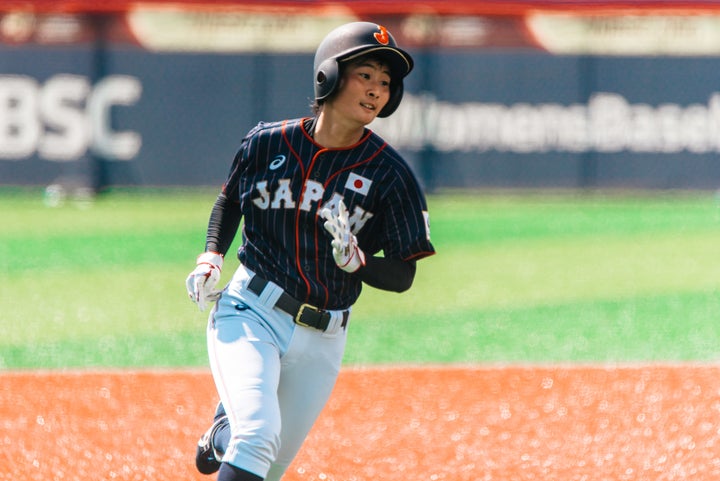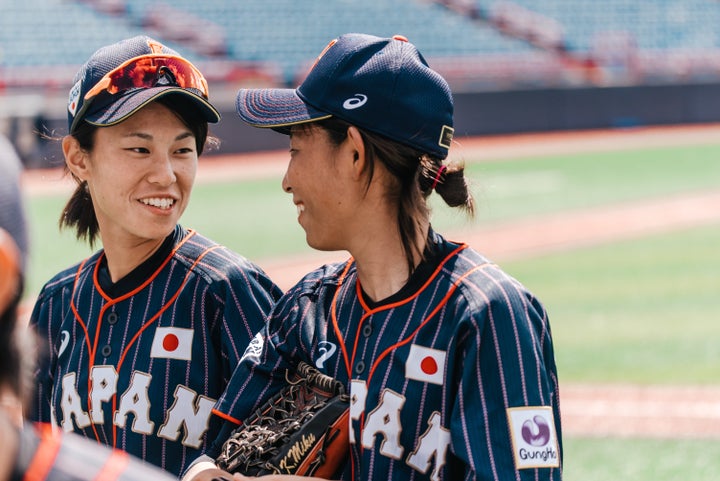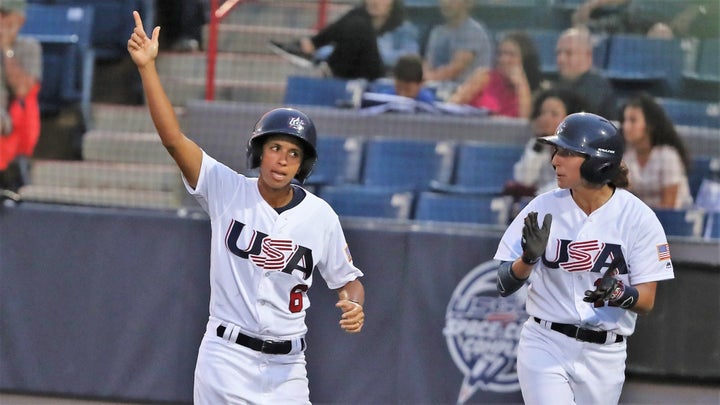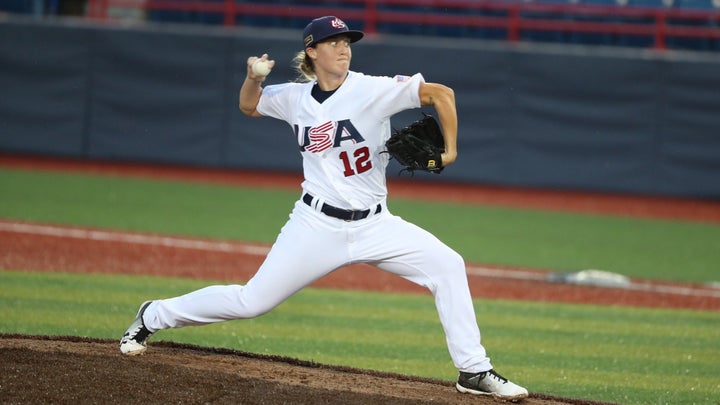
The world’s only active professional women’s baseball league was started in Japan in 2009 by the president of a health food company. The story goes that Kenichi Kakutani of Wakasa Seikatsu, a maker of supplements that “address things like specific eye problems and inner fragrance,” was moved to do something after watching a baseball tournament for high school girls.
As a spokesperson for the league told The New York Times in 2012, “he wanted to create an environment where they could focus on baseball and make money playing.”
Thus was born the Japanese Women’s Baseball League (JWBL). It’s tiny ― four teams in all ― but it exists. And it goes a long way toward explaining why, on the women’s side, America’s pastime is dominated by Japan, the smart money to win the Women’s Baseball World Cup, which opened Wednesday. It’s the infrastructure — inner fragrance, you might call it.
Most Americans’ knowledge of women in baseball comes from the 1992 film “A League of Their Own,” from which we learned that there is no crying in baseball and that during World War II and for a few years after the war, women played in the All-American Girls Professional Baseball League. Perhaps some have heard that a few women also played in the Negro Leagues, or maybe they watched Mo’ne Davis pitch in the Little League World Series a few years ago, or perhaps they caught an episode of the recent but canceled-too-soon fictional drama “Pitch,” which imagined what life would look like for the first woman to play in Major League Baseball.
The history of women in baseball, though, is as long as the history of men in baseball. “Women have always played the game,” says Kat Williams, a professor of women’s sports history and the president of the International Women’s Baseball Center. Since the 19th century, “we’ve always umpired and coached and tended the fields and kept the stats and owned the teams.”
And women are playing today. In fact, the very best female baseball players from across the world are in Viera, Florida, to participate in the Women’s Baseball World Cup, which runs until Aug. 31. The tournament has been held every other year since 2004, and this year features 12 teams: Japan, USA, Venezuela, Dominican Republic, Chinese Taipei (Taiwan), Hong Kong, Cuba, Korea, the Netherlands, Puerto Rico, Canada and Australia. Together, they represent five different continents.

This is the first time the event is being played in the United States. But the U.S. Women’s National Team is not the team to beat. Japan is the top-ranked team in the world and the winner of the last five World Cups. The team has won 21 straight games, its last loss at the World Cup coming in 2012 against the United States.
Ayami Sato, Japan’s star pitcher, is probably the best female baseball player in the world. She won the MVP award at the last two World Cups after shutting out the eventual silver medalists in the final (in 2016, Japan beat Canada; in 2014, the United States).
The JWBL has a lot to do with the country’s dominance. The women in the league play much more often at a higher competitive level than just about anyone else in the world.
Oscar Lopez, the head of communications for the World Baseball Softball Confederation, the organization that puts on the WBWC, says that the Japanese team has “a lot of support [from baseball fans] and also a lot of commercial support, sponsors, which may or not be an advantage to other nations.” He points out that this year, Forbes ranked the JWBL 16th among “the most powerful women in international sports.”
The average attendance at JWBL games is roughly 1,200, but on the high end, games can attract upward of 5,000 spectators, JWBL spokesperson Kana Kawabata told HuffPost via email. For the women’s game to grow in Japan, it won’t be enough for the league to expand; Kawabata would like to see more female teams at the high school level, too.
That’s another thing about Japan: The country has a pipeline from youth baseball to the pro league, something the U.S. can only envy at this point.
“What we’re imagining is women in the major leagues, but that’s not even the issue. The issue is, why can’t we deal with the fact that girls and boys should play baseball together when they’re little?”
- Jennifer Ring
Despite the positive impact that Title IX has had on women’s sports in the United States, it created a “separate but equal” regime that, in some ways, entrenched sexist assumptions about women and sports. This is particularly apparent with respect to baseball and softball, long held to be his and hers equivalents, even though the games are very different, down to the size of the field itself.
Baseball could skirt Title IX rules and regulations regarding equal access because women already had softball. Plenty of girls play baseball when they are young, but by the age of 12, when Little League ends, most have been pushed out of the sport. Some play middle school ball, though often as the only girl on an otherwise all-boys team. Fewer still play baseball in high school. Only a handful have ever played collegiate baseball, and there are some women who have played on a professional men’s team in the minor leagues and independent pro leagues.

And then there is the U.S. Women’s National Team, which began in 2004, the same year as the first Women’s Baseball World Cup. Both were formed after years of grassroots efforts to establish an international presence for the U.S. in women’s baseball and after a series of more informal competitions.
There is nothing connecting the national team to those young girls on the diamonds — no IMG Academy program, no national AAU circuit, no equivalent to soccer’s AYSO. What infrastructure does exist is regional and amateur.
American girls who play baseball are often left to make their own way, which they do because of how much they love the sport.
To witness the distance between how girls and women’s baseball is valued in this U.S., all you have to do is turn on your TV. There, you will find the Little League World Series on the Worldwide Leader in Sports. If you want to watch the Women’s Baseball World Cup, you have to go online to the YouTube channel for the World Baseball Softball Confederation, the organization putting on the tournament, and stream the games there.
Japan has a different relationship to baseball than the United State does, in part because “baseball in Japan happens in the spring and summer when it’s in the middle of the school year,” says William Kelly, a professor of anthropology and Japanese Studies at Yale. “So, baseball’s actually the equivalent of basketball or football here in the U.S., at the high school and college level. Everybody pays attention to it.”
There are only a handful of public high schools in Japan with girls’ teams but, Kelly says, roughly 25 or 30 private high schools have them. “The girls who want to play baseball can go to a private high school,” he explains. “They can go to a university, or they can join the professional women’s league, and they can aim for the national team and get enough support that they can actually train for it.”
Japan has “an organizational structure there that can take girls to the national team that we don’t have here in the U.S.,” he added.
“American girls who play baseball are often left to make their own way, which they do because of how much they love the sport.”
Still, it’s important to put the league in context. According to Kelly, while baseball is the most popular sport in Japan, the women’s version remains on the fringe.
“Women’s baseball, unlike say, women’s soccer, is in double jeopardy,” Kelly explains, “because women’s baseball is completely eclipsed by men’s baseball and has been, in Japan and the U.S., since the late 19th century, in the few times when women were able to play organized baseball. But it’s also in jeopardy to softball, because girls get tracked into the softball very early on.”
Softball, a sport originally created so that men could play baseball during the frigid winter months, was useful to men in different countries as they professionalized the sport of baseball and needed somewhere to direct women interested in a stick-and-ball game.
On the website for Little League, there is a timeline of major moments in the organization’s history. There are only two listed for 1974, and they are: “Little League rules are revised to allow participation by girls,” and “Little League Softball and Senior League Softball programs are created.” The former happened only because a court forced Little League’s hand. Little League officials fiercely contested the gender integration of baseball, with one league president worrying about incurring lawsuits should girls “get breast cancer from getting tagged out on the boobs.” The creation of the softball program shows how deliberately that sport was used to keep girls out of baseball.
It was a very effective technique that has now been entrenched throughout the world. Dana Bookman, founder of the Canadian Women’s Baseball Association, says she accidentally started an all-girls baseball league in 2016 when she put out feelers to try to find other girls to play baseball with her 6-year-old daughter. Bookman’s daughter had been the only girl in a league with roughly 400 boys, and had decided she didn’t want to play anymore.
There are now about 1,000 girls playing in leagues under CWBA auspices in three different provinces. This isn’t too surprising in Canada, which has a more robust (though still wanting) infrastructure for girls and women’s baseball than the U.S. does, including the annual Baseball Canada championships for U16 girls, U21 women and senior women’s teams from different provinces. Despite this popularity, Bookman says that she has had people say to her face, “Girls play softball, boys play baseball.”

This idea that only boys play baseball is wrong. And more and more, it seems people are starting to appreciate that. The International Women’s Baseball Center was created a few years ago out of a general sense that change was coming, said Kat Williams, its president.
Williams can remember the eureka moment, down to the date: “Feb. 22, 2014, a group of us sat round over pizza and beer,” Williams said. She explained that they came up with the idea for the IWBC because “we felt that shift.”
The women involved in the IWBC knew there was “not a women’s baseball museum or educational center or focal point.” The center is being built in Rockford, Illinois, across the street from Beyer Stadium ― where the Rockford Peaches, of “A League of Their Own” fame, played. The center’s focus will be on education and preserving history.
The center also supports the annual Baseball For All national tournament, which recently concluded its fourth contest. This year, there were 24 teams and nearly 300 girls who competed. According to Justine Siegal, who founded BFA in 2010, the tournament is a yearly culmination of the work her organization does to help communities start their own girls’ teams or find a team nearby on which girls can play.
For Williams, the BFA tournament is a moment during which you can take in the history of women in baseball and also glimpse its future. You can see 91-year-old Maybelle Blair and 85-year-old Shirley Burkovich, two former players from the All-American Girls Professional Baseball League, greet each of the girls during the opening ceremonies. “And you have not lived until you have watched 10-year-old girls march in in their baseball uniforms into the arms of 91-year-old Maybelle Blair,” Williams says.
For those girls who participated in the BFA tournament, and really any girl who plays baseball in the U.S., their main goal is to play on the USWNT. “Nearly every single one of those girls at the Baseball For All tournament, when asked, ‘What do you want to do?’ their answer is, ‘Play for the U.S.A. team,’” Williams said.
To do that, though, one has to find a way.
“Nearly every single one of those girls at the Baseball For All tournament, when asked, ‘What do you want to do?’ their answer is, ‘Play for the U.S.A. team.'”
- Kat Williams, International Women's Baseball Center
Ashley Bratcher, senior director of baseball operations at USA Baseball, says that the World Cup is a “three-week opportunity” for many of the women competing who otherwise do not get to play on the highest levels in baseball. “They all have jobs and families,” she said, and “are juggling that to prepare for this stage.”
Training is an ad hoc affair. On the U.S. women’s team, Bratcher says, one player “owns a CrossFit gym, so she’s got a built-in way to stay in shape. Some are hitting instructors or giving lessons and things like that, so they’ve got regular access. Then you’ve got others who are hitting off a tee in the backyard and juggling being a mom, or going to a local high school to find someone who will catch a bullpen for them so they can get their pitching in.”
While there is a romantic element to this ― the hard-working woman who loves baseball so much she does whatever she can against whatever odds to play for her national team ― it’s mainly frustrating. Veronica Alvarez, a former member of the U.S. national team and now the pitching coach for the team at the World Cup, says: “Being Team USA, you expect gold. And the people, I assure you, among the higher-ups, they expect gold out of us.” But she wonders how anyone could expect gold from a team whose players see each other only at the trial and then for one week of practice together before the tournament.
“It’s hard to go from being a woman with a full-time career to practicing two-a-days, and getting her body ready, and on your own time,” Alvarez says. “It’s hard because nobody really sets us up for that success.”
Alvarez says that the women on the team will take what they call “baseballcations.” On their own and paid for out of their own pockets, small groups of players will choose a city and a weekend where they can meet up to practice. “They’re having these baseballcations in Jacksonville, and Atlanta, and different parts of the country where they’re able to come together. Whether it’s four of them or six of them, they’re finding the way to do it.”
“Being Team USA, you expect gold. And the people, I assure you, among the higher-ups, they expect gold out of us ... It’s hard because nobody really sets us up for that success.”
- Veronica Alvarez, former member of the U.S. national team
Baseball For All founder Siegal knows the importance of the national team for the growth of the women’s game in the U.S., but she’s also realistic about how far the country has to go. “It’s correct to think that the Women’s National Team has inspired girls to stay in baseball,” she says. “I think it’s also correct to say we still have a major challenge in the U.S. of encouraging girls to stay in the game.”
There is support these days from Major League Baseball through its Trailblazers and Breakthrough Series, and there’s hope that having the U.S. host the Women’s Baseball World Cup this summer will capture attention for the sport.
Yet Siegal cautions that for real change to occur, “the next step is actually implementing that support at the local level so that girls as young as six and seven aren’t automatically shuffled to softball, but rather given the true opportunity to play baseball or softball.”
Jennifer Ring, a professor of political science and author of Stolen Bases: Why American Girls Don’t Play Baseball, echoed Siegal’s thoughts. “What we’re imagining is women in the major leagues, but that’s not even the issue. The issue is, why can’t we deal with the fact that girls and boys should play baseball together when they’re little?”

Maybe one day, the United States will have a small professional women’s league like Japan ― and then it will benefit, like Japan does, from its national team players spending so much more time on the mound, behind the plate, or out in the field.
Maybe a rich CEO will see the women playing in the Women’s Baseball World Cup and decide he needs to help fund part of the pipeline and give these women more of a chance to play the game they love.
Through her work, Ring knows some of the players on the USWNT really well. Thinking about the team taking the field in Florida and competing against the best female baseball players in the world, she can’t help but feel a little sentimental bias. “They’re these great women who deserve gold,” she said. “And I hope they get it for their sakes.”
But there’s a larger picture. “If we’re not really going to support girls’ baseball as a nation and nurture the girls to a national team, of course we’re not gonna beat Japan,” she said. “In a sense, Japan deserves to win.”
